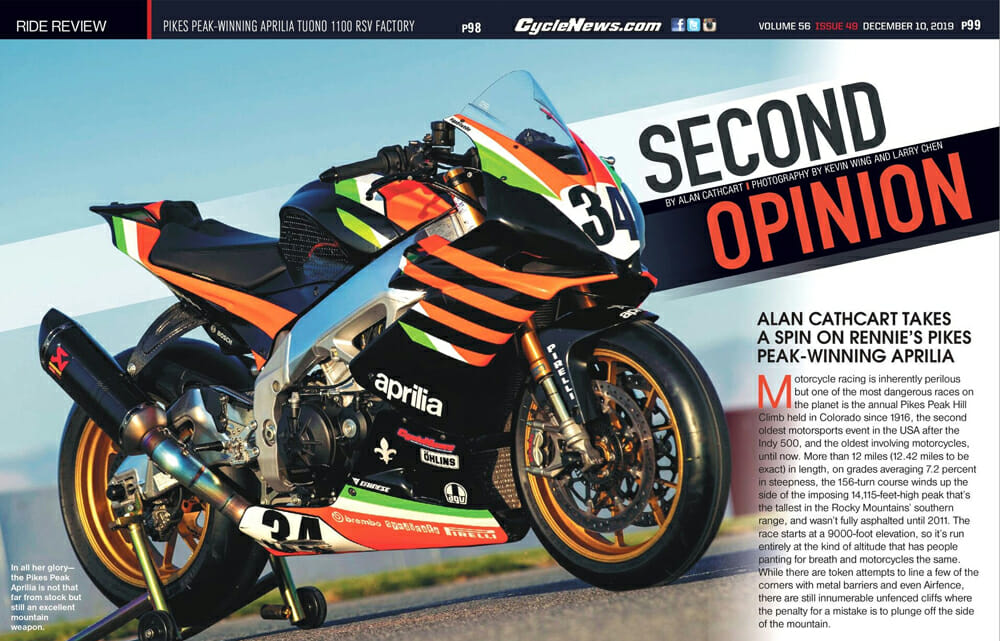Alan Cathcart | December 13, 2019
Alan Cathcart takes a spin on Rennie’s Pikes Peak-winning Aprilia Tuono 1100 RSV Factory racer.
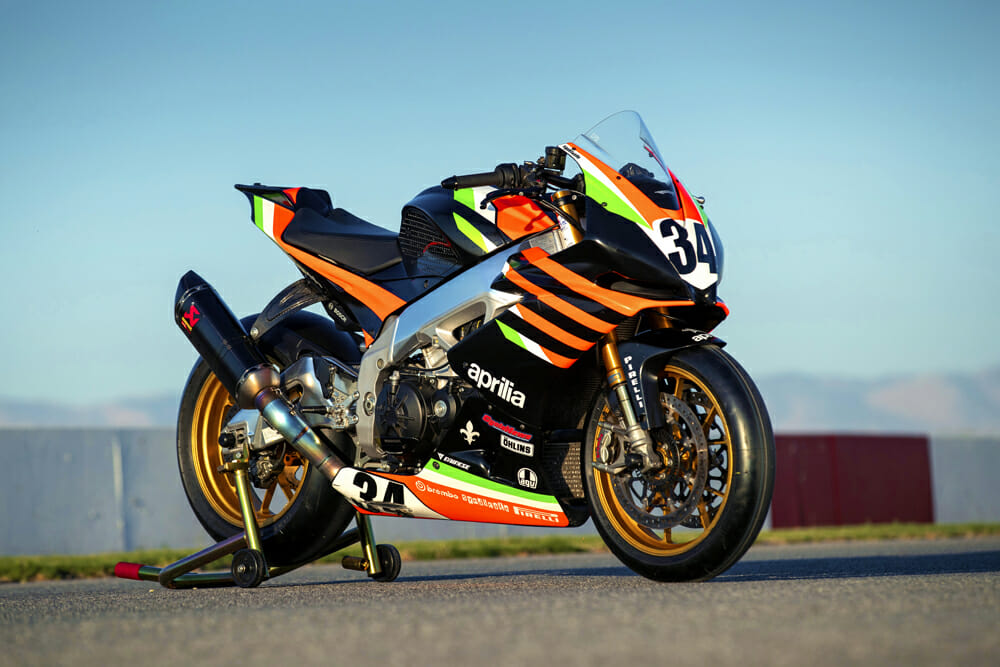 In all her glory—the Pikes Peak Aprilia is not that far from stock but still an excellent mountain weapon.
In all her glory—the Pikes Peak Aprilia is not that far from stock but still an excellent mountain weapon.
Photography by Kevin Wing and Larry Chen
Motorcycle racing is inherently perilous but there is no more downright dangerous race on the planet than the annual Pikes Peak Hill Climb held in Colorado since 1916, the second oldest motorsports event in the USA after the Indy 500, and the oldest involving motorcycles, until now. More than 12 miles (12.42 miles to be exact) in length, on grades averaging 7.2 percent in steepness, the 156-turn course winds up the side of the imposing 14,115-feet-high peak that’s the tallest in the Rocky Mountains’ southern range, and wasn’t fully asphalted until 2011. The race starts at a 9,000-foot elevation, so it’s run entirely at the kind of altitude that has people panting for breath and motorcycles the same. While there are token attempts to line a few of the corners with metal barriers and even Airfence, there are still innumerable unfenced cliffs where the penalty for a mistake is to plunge off the side of the mountain.
Even riding up the relatively narrow road leading to the peak on a street bike is a daunting experience, which made me all the prouder—as well as all the more relieved!—to hear on June 30 this year that 36-year old Rennie Scaysbrook had finally achieved his four-year ambition of becoming the King of the Mountain.
VIDEO | Cliff Racer III: Racing To Win At Pikes Peak 2019
He did so by winning this year’s Pikes Peak event outright on an Aprilia Tuono 1100 Factory (click here to read Scaysbrook’s Race to the Clouds), after three years of riding a KTM there to finish second twice, and fourth once. He became the first Australian to win the event by smashing the existing course record by a massive 4.662 seconds in setting a time of 9:44.963, to achieve his principal target of defeating the other factory-backed entries from Ducati, BMW and Zero in winning the Heavyweight Division category. Tragically, though, his closest rival (and friend) for outright victory Carlin Dunne (the same age as Rennie) and a four-time previous winner of the event, was killed after inexplicably crashing at the very last turn aboard the Ducati factory’s prototype V4 Streetfighter running in the Exhibition class. Now do you see why I was so relieved that Rennie had survived the race intact?
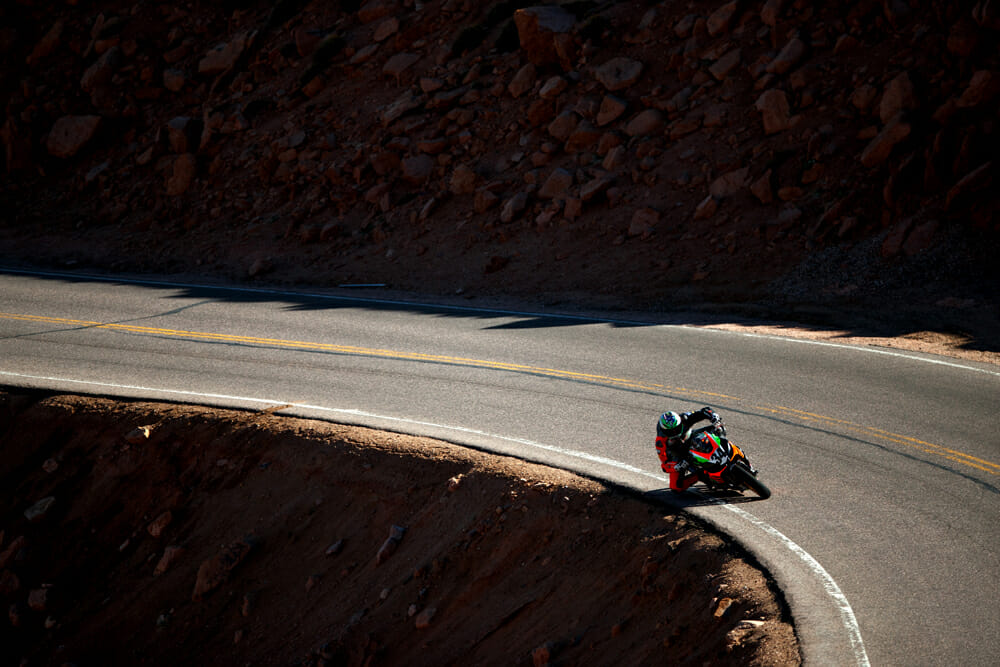 Scaysbrook charges through the mid-section during practice for the 2019 PPIHC.
Scaysbrook charges through the mid-section during practice for the 2019 PPIHC.
That’s because the young (well, he is to me!) Aussie has been a semi-detached member of the Cathcart family ever since he came to stay with us in England at the age of 11. My friendship with his dad, Jim, the first Aussie to race in the AMA 500cc MX Championship, as well as Mike Hailwood’s teammate on the Great Man’s return to road racing in 1977/’78, led to Rennie and I also becoming the best of friends, and now colleagues on the Cycle News masthead.
In 2018, Rennie suffered the heartache of winding up second aboard a KTM 1290 Super Duke R to factory Ducati rider Dunne by a mere 0.692 seconds, cracking the 10-minute barrier for the second time in the closest-ever finish at Pikes Peak. “That one really stung,” says Rennie, “so there wasn’t any question about coming back in 2019 to try to turn the tables. But doing so meant switching brands, so I was about to start looking around to see who might help out, when Shane Pacillo from Aprilia took me to lunch, and asked if I’d be interested in doing it on a Tuono 1100 Factory!”
California-based Pacillo is PR & Event Manager for Piaggio Americas, covering Latin America as well as the USA and Canada, and he’d watched the hefty publicity payoff both Ducati and KTM had obtained from success at Pikes Peak with some envy.
“Aprilia’s brand ethos is all about racing,” he says, “and the American market needs as much representation in significant events here in our Western hemisphere, let’s call it, as it does in Europe. So I pitched the notion of supporting Rennie to my bosses here and in Italy, and they liked the idea. He liked it even better, so now we had to deliver!”
Rennie had a clear idea of what he needed, and that involved hiring Jeremy Toye as Crew Chief. Toye, 48, is widely regarded as one of America’s best-ever open roads racers, and won Pikes Peak in 2014 on his self-built Kawasaki.
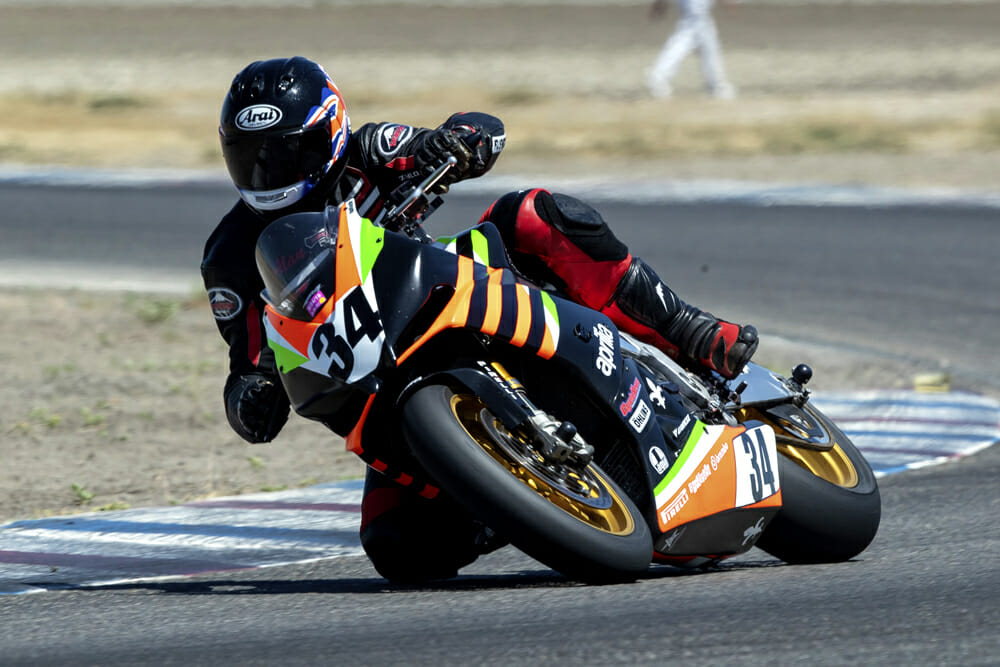 Cathcart banks the Aprilia in. Even with the taller suspension, you can see there’s barely any room left under the belly pan.
Cathcart banks the Aprilia in. Even with the taller suspension, you can see there’s barely any room left under the belly pan.
“I wanted Jeremy on board because I knew that he knew what’s required to win there,” says Rennie. “I especially wanted his input into the chassis side of things, because I thought we had the KTM too stiffly set up in 2018. So this year we went the opposite way and made the Aprilia a much more compliant bike, I figured with the little bit less torque it has as a V4 against the V-twins, to get the thing around the corners faster it would be better to have a bit more of a road bike feel to it.”
So a brand-new 2019-model Tuono 1100 Factory was shipped to Toye’s shop in San Diego, to be built up as a PP racer with several parts cannibalized off an RSV4 1100 Factory. Aprilia chose not to run its street-legal Superbike in the race because the Heavyweight Division at Pikes Peak caters exclusively for production motorcycles originally delivered with a one-piece handlebar. Otherwise, they’re only allowed to run in the Exhibition Prototype class (still with a one-piece handlebar, but not as original equipment from the factory), essentially an Open category catering for everything from factory prototypes and home-built specials to Superbike racers. The marketing kudos for manufacturers comes from winning the Heavyweight Division.
The Tuono’s 1078cc 65-degree V4 engine was left completely stock, but with the addition of an aftermarket Akrapovič titanium exhaust. But after much experimentation the team finally settled on ultra-low overall gearing of 15/54, compared to 15/42 as stock! That’s the sort of gearing stunt riders opt for, but Rennie had a good reason for fitting it. “At the tire test we did earlier in the month, I was like, this thing is so slow! We knew we had exactly 170 bhp at sea level, but when we got to altitude at 6,000 feet, we were at 160 when we first mapped it, and then we had issues with the fuel type during race week. So then when we changed the map with the correct fuel we’d lost about eight bhp more. We actually got back up to 162 bhp by race day, but it was a serious amount of work for the guys to do at the dyno. So, we decided to drop the gearing so that the bottom three gears would flash by in an instant, and I’d spent most of my time in the top three gears, except for in the hairpins where it was always bottom gear, to get a hustle out of the bend. It worked. I think you’d only get about 140 mph out of the bike if you’re lucky, but it gets there really quickly!”
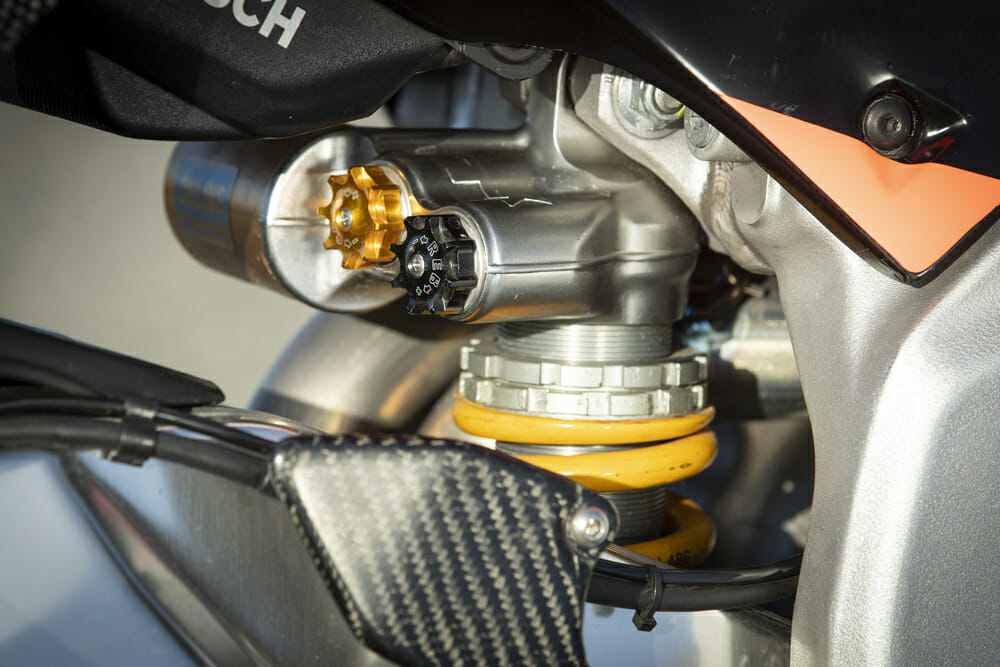 Ӧhlins TTX36 shock came straight from the RSV4 1100 Factory…
Ӧhlins TTX36 shock came straight from the RSV4 1100 Factory…
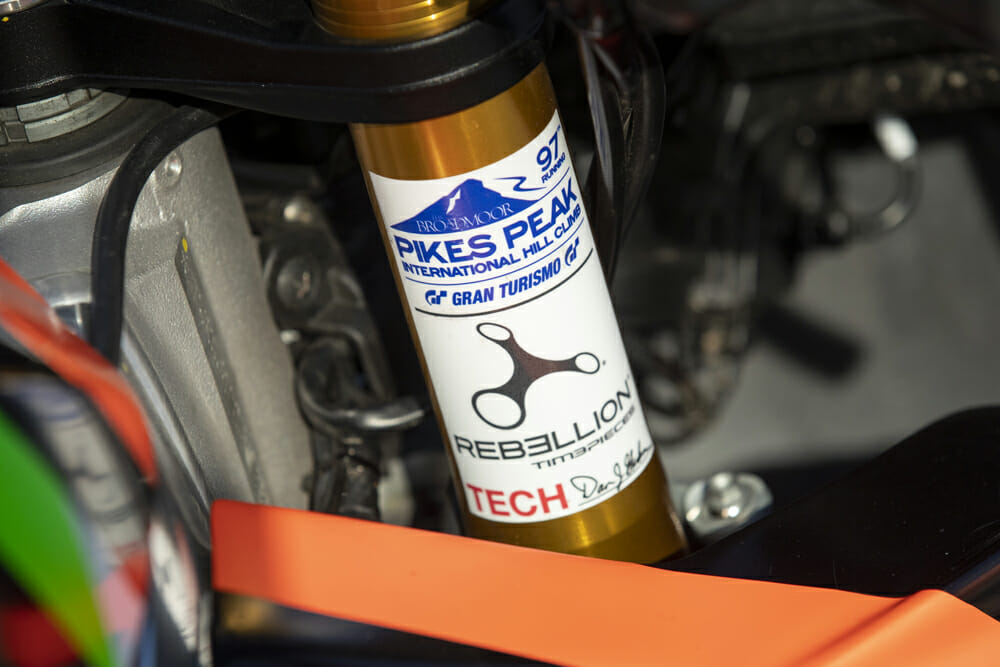 …As did the NIX30 fork.
…As did the NIX30 fork.
Toye then fitted the 5mm longer fully adjustable 43mm Öhlins NIX30 fork from the RSV4 1100 Factory street bike, and its 10mm longer TTX35 rear shock.
“My biggest concern was the Aprilia not having enough ground clearance,” says Rennie, “especially with the belly pan that we run on it. When you’re leaned over, especially in Boulder Park, there’s a number of big undulations that crunch the bottom of the bike when you go over them, so you really need to stand it upright and lean off it as much as you can, to minimize damage.”
RSV4 RF forged aluminum wheels were installed, with the 6.00-inch rear housing a 200/60-17-inch Pirelli Diablo Superbike tire.
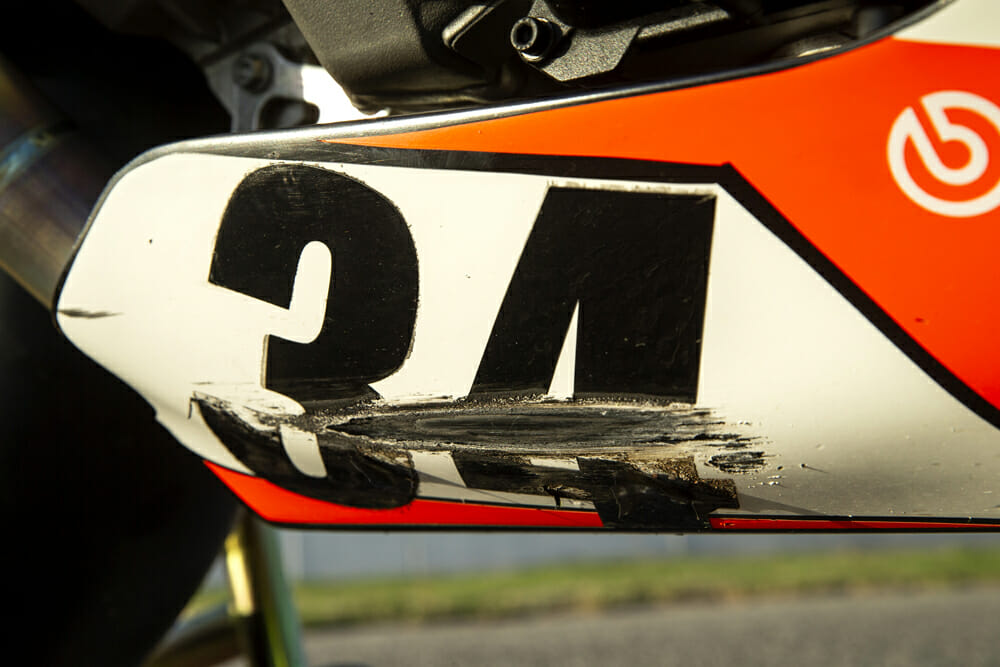 Boulder Park still caused a few scrapes and bumps on the Tuono.
Boulder Park still caused a few scrapes and bumps on the Tuono.
The longer suspension resolved the ground clearance problem, mainly derived from the fact that Rennie had opted to run such soft suspension settings on the Aprilia. I discovered this for myself a couple of months after his winning exploits, when he and Shane Pacillo brought the victorious Aprilia to Buttonwillow Raceway for me to sample. From riding the Tuono in Italy I could already well imagine that Scaysbrook & Co. didn’t need to worry about tuning up the motor, just on putting its broad spread of torque and appetite for revs to best advantage. This had initially proved difficult at Pikes Peak, as Rennie explains: “Even on Race mode, the throttle valves basically weren’t opening up as fast as I wanted them to,” he says. “I’d get on the throttle, and it just wouldn’t accelerate at anything as fast as I was asking it to, and it was killing us, especially in the mid-section, because there, it’s just drag racing, and you need instant go.”
Aprilia tried to help by emailing various new maps over from Italy, but for day three, the Italian factory flew over calibration engineer Nicola Marcato, who also road races in his spare time, to try to fix the problem. Which he did!
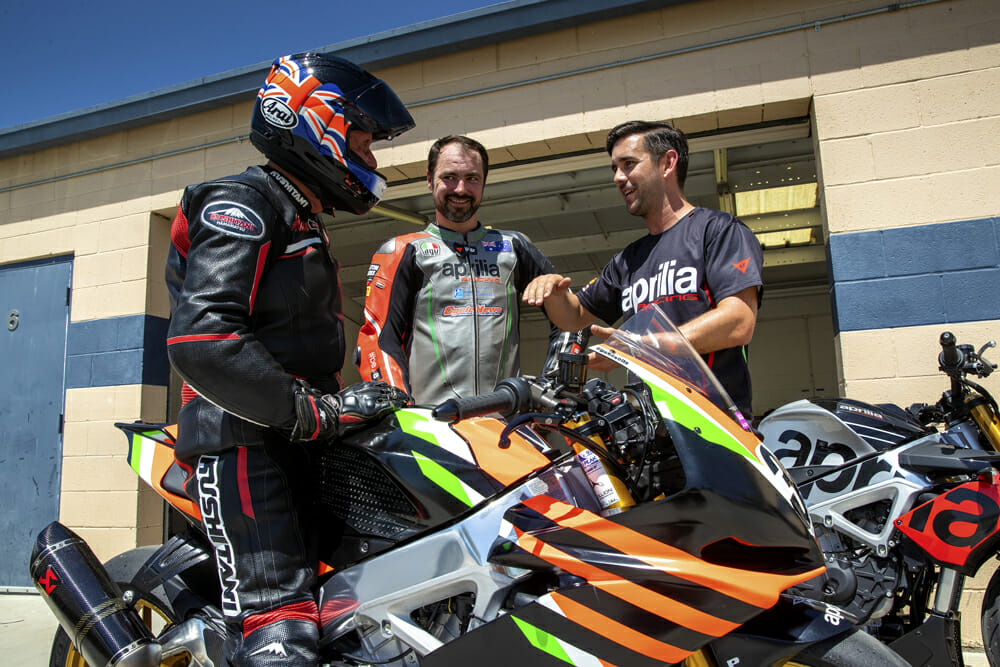 Cathcart gets the good word from team manager Shane Pacillo.
Cathcart gets the good word from team manager Shane Pacillo.
The chassis side was where Toye spent most time, firstly transforming Aprilia’s Naked hot-rod into a racer by fitting Attack Performance rear sets, and a SharkSkinz replica RSV4 seat and fairing, which was then painted and wrapped in a fetching Italian tricolore colour scheme by Syndicate Racing in Denver, Colorado. Toye then rotated the handlebar 10 degrees downward to compliment the RSV4 fairing.
“Nicola came with a trick Marelli ECU!” beams Rennie. “He plugged that in on the third day of practice, and it just completely transformed the bike, within 100 meters I was like, ‘okay, let’s go!’ It gave me exactly what I was looking for. Nicola fine-tuned it for us right up to the race, then installed the same map in the stock ECU for us, because he had to take the trick Marelli ECU home with him. So it’s supposed to be now just the same as what I raced with.”
Rennie confirmed this during a handful of shakedown laps, during which he also kindly scrubbed in the new set of super-soft Pirelli Diablo Superbike tires furnished for my test. Hopping aboard for my first of three 20-minute sessions on the bike revealed a slightly higher (seat height is 33.1inches vs. 32.5 inches stock) and more spacious riding position than the stock Tuono I’d just been riding to re-learn the circuit on, reflecting Rennie’s slightly taller height. But this, coupled with the flat stock handlebar that’s slightly tilted down to let you tuck better behind the screen on straights, allows you to lever the bike around quite easily, especially through tight turns. You don’t need to hang off it to get it to steer, so wasn’t as physical a ride as I was expecting.
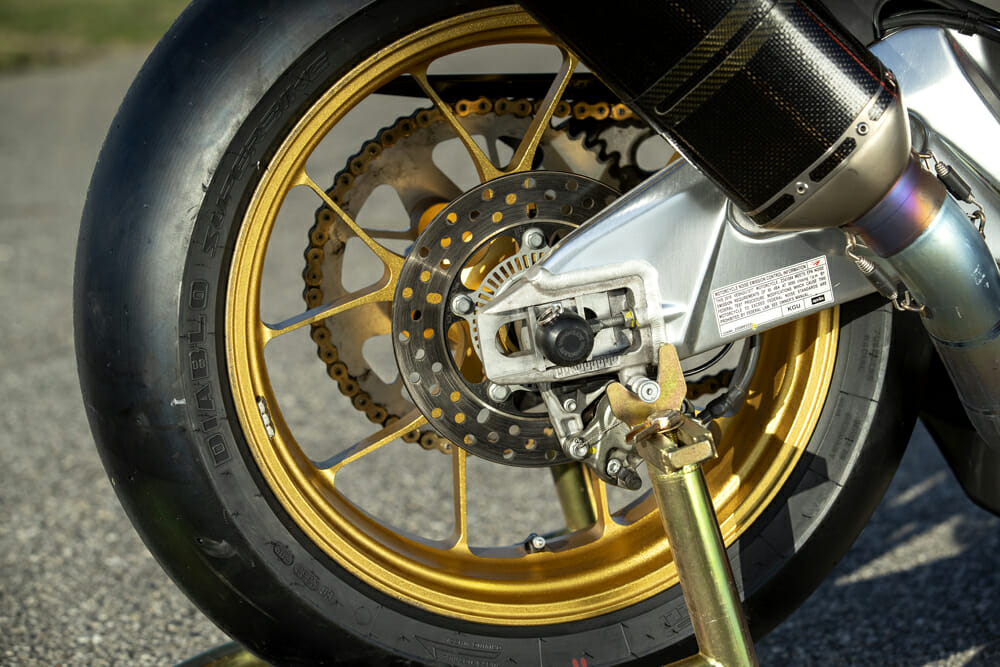 Gold wheels were swiped off an RSV4 RF from 2014.
Gold wheels were swiped off an RSV4 RF from 2014.
However, it does pay to do all your braking in a straight line, if possible, then turn in quite late to the apex so as to have space on the exit to carry decent turn speed. That’s because braking hard while leaned over will make the Aprilia try to sit up and understeer, which you must then counter with a good tug on the handlebar, while shifting your body in the seat. However, the braking is superlative thanks to Brembo’s best, with the twin 330mm floating front discs gripped by four-piston radial M50 Monoblock calipers and a race-spec Brembo master-cylinder, with the stock Bosch ABS disconnected. Just a single finger on the lever slows the Aprilia down from hard on in sixth gear to third, leading into Buttonwillow’s first blind hilltop turn, where the Tuono’s confidence-inspiring handling let me choose the precise line almost inch-perfect every lap, after I’d learned it by following the local track day experts. Thanks, guys!
There, despite the slipper clutch I’d gained welcome added engine braking in shifting down to third just before climbing the short incline on the same Race mode Rennie says he used for the race. That’s where the unique engine braking map which Nicola Marcato dialed in really came to the fore. Basically, from the 12,500 rpm rev-limiter, which, thanks to the short PP gearing, I was hitting twice per lap at Buttonwillow, down to 9,000 revs the Tuono essentially freewheels, but from there on down to around 4,000 rpm there’s constantly increasing engine braking. This not only helps stop the bike, but also pulls you nicely into the apex of the turn, with the slipper clutch ready to help prevent any rear wheel chatter. Moreover, there’s little trace of instability even when leaning on the brakes, which does indeed cause some front end dive thanks to those soft but compliant suspension settings, but not at the expense of directional control.
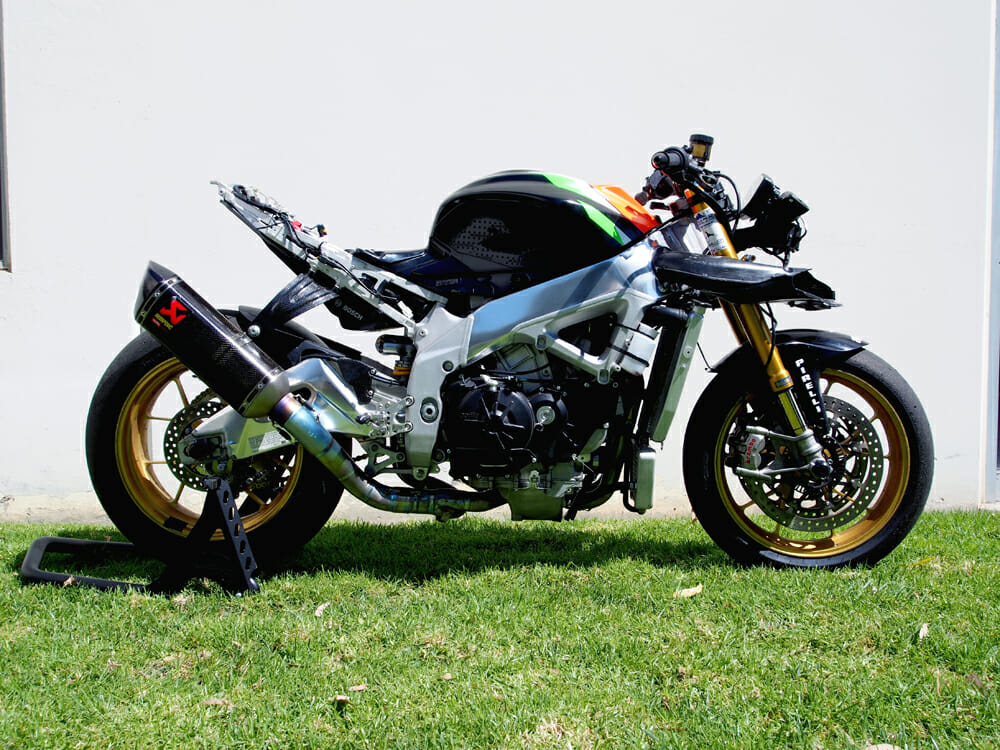 Stripped bare, there’s not much on the Tuono that isn’t on a stock Tuono.
Stripped bare, there’s not much on the Tuono that isn’t on a stock Tuono.
That glorious engine is as much of a gem in the PP-winning bike as I’ve grown used to it being on my various rides with it in Italy. The V4 motor starts delivering serious performance as the tacho needle hits the 5,000 rpm mark, and engine acceleration starts to pick up faster. From 7,000 rpm upwards acceleration becomes explosive—it’s the only word to use for it—in the Sport mode Rennie used for the race and with peak torque delivered at 9,000 rpm, I found that was where the front wheel will start to pop up lazily off the tarmac exiting a turn in second gear, making me glad I had the Öhlins steering damper well wound up. Rennie must have switched off the AWC/anti-wheelie program, besides dialing the eight-stage TC down to Level 1.
But then hold the gear and at 10,000 rpm there’s another dose of top-end power that will send you rocketing forward as the engine heads for the rev-limiter in a way that’s seriously satisfying, and definitely dramatic. You can’t help but appreciate the smoothness of the perfectly dialed-in two-way powershifter, complete with an auto-blipper for clutchless downshifts punctuated by a musical blip from the distinctive note of the V4 motor as you hook a lower gear.
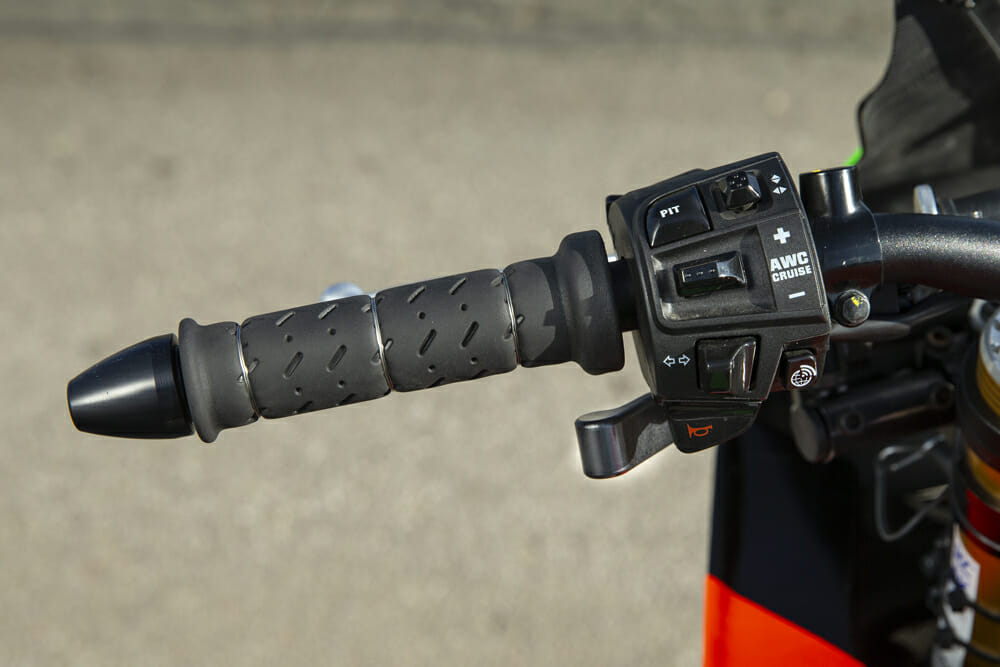 Scaysbrook had a Brembo thumb brake fitted to the Aprilia, something he immediately gelled with.
Scaysbrook had a Brembo thumb brake fitted to the Aprilia, something he immediately gelled with.
Fourth gear on the PP gearing was especially useful at Buttonwillow, which thanks to the widespread of torque I could hold for a good part of the infield without sacrificing drive. At first, I really needed to force myself to use at least one gear higher than I might have done normally because of the low overall gearing, but the Tuono’s flexibility and wide spread of torque, which peaks at 9,000 rpm with 89.9 lb-ft on tap, makes it much less important which gear you throw at it. However, it does pay to rev it right out to the limiter, because there’s definitely more power up high which it pays off to access.
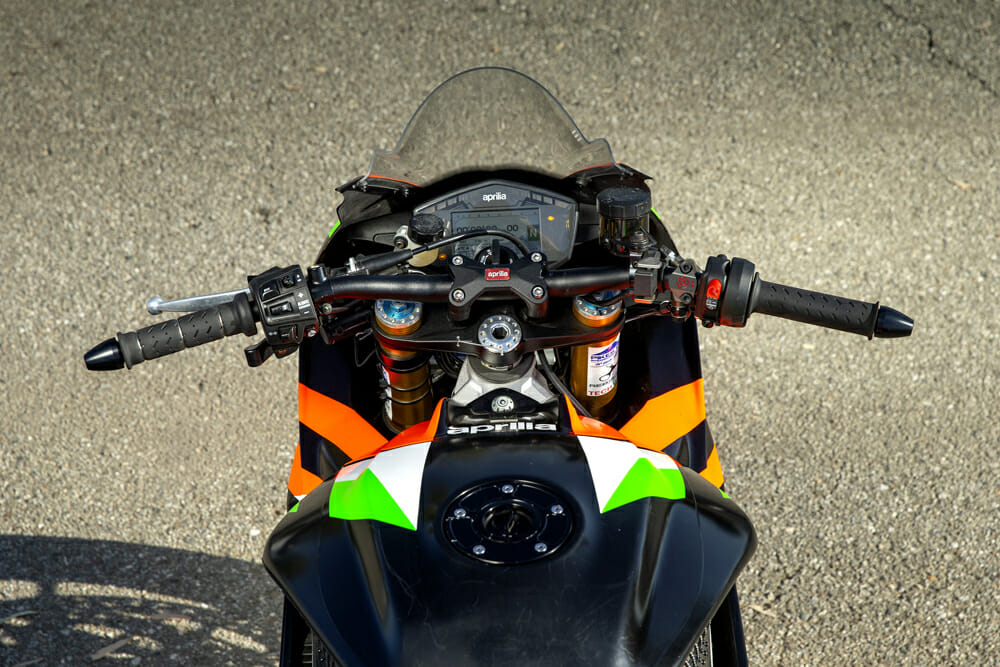 Mission control for the Pikes Peak racer. Notice how the traction control switches were moved from the left to the right (next to the kill switch) to facilitate the thumb brake.
Mission control for the Pikes Peak racer. Notice how the traction control switches were moved from the left to the right (next to the kill switch) to facilitate the thumb brake.
The soft suspension was only really noticeable under hard braking, when the weight transfer was something to remember, though ride quality over Buttonwillow’s several bumps underlined why Rennie preferred such a setup at Pikes Peak. I tried to use his thumb brake as intended, and actually came away quite impressed—best of all was using it first before squeezing the front brake lever. This preloaded the rear suspension before moving the weight transfer forwards via the front brake, resulting in a more balanced approach to turns, and ultimately making it easier to keep up turn speed. By the end of my third and final session I was starting to get the hang of it. To be continued!
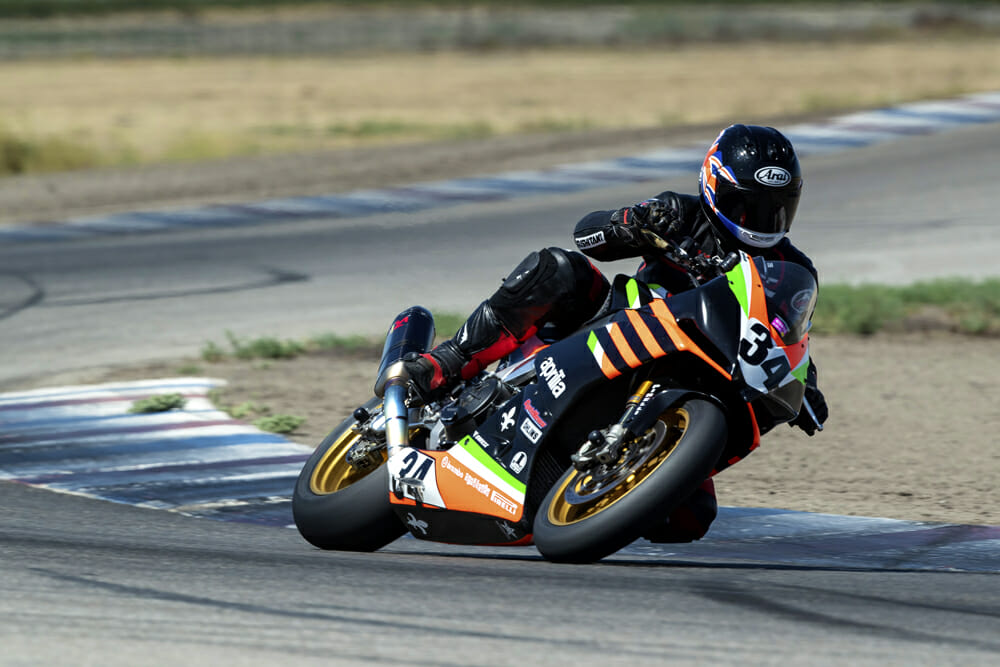 Cathcart came away from the test beaming.
Cathcart came away from the test beaming.
That’s sadly not however the story of the Pikes Peak-winning Aprilia, for after Carlin Dunne’s tragic passing, it’s been confirmed there’ll be no motorcycle race there in 2020. This makes it quite likely that Rennie Scaysbrook may be the all-time record holder on two wheels for the course, and the Aprilia a very historic motorcycle. Piaggio flew the bike to Europe for the EICMA Show last month, since it’s been quite a long time since they won anything to boast about! But it’s surprising they haven’t concocted a 50-off limited edition street replica of the Pikes Peak-winning Tuono, just as Ducati has consistently done after its wins there (there is a U.S. Pikes Peak Tuono named the Summit Attack, but that’s only a paint job and oddly released before the race start).
Many believe the street Tuono 1100 Factory is the finest real-world road bike that money can presently buy. Seems it works pretty well at altitude, too!CN
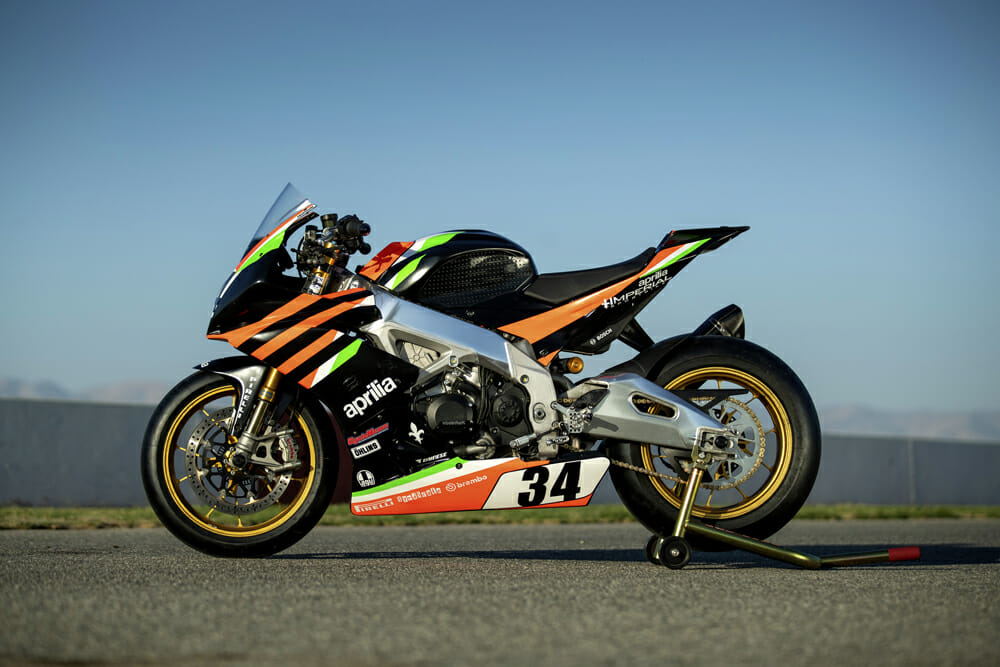
Aprilia Tuono V4 1100 RSV4 Factory Pikes Peak Racer Specifications
| Engine: |
Water-cooled, DOHC, 65-degree, V4, 4-stroke, 4 valves per cylinder, modular gear/chain camshaft drive |
| Bore x Stroke: |
81 x 52.3mm |
| Capacity: |
1078cc |
| Output: |
175 bhp/129 kW at 11,000 rpm (at sea level, at rear wheel) |
| Compression ratio: |
15:1 |
| Fuel/ignition system: |
Electronic fuel injection and engine management system, with Aprilia Racing/Magneti Marelli APX2 ECU, 4 x 48mm Weber-Marelli throttle bodies, single injector ea., plus Power Commander |
| Transmission: |
6-speed extractable cassette-type with straight-cut primary gears |
| Clutch: |
Multiplate oil-bath ramp-type slipper clutch, cable operation |
| Chassis: |
Twin-spar aluminium frame with vertically adjustable engine location |
| Front Suspension: |
Fully adjustable 43mm Öhlins NIX30 inverted telescopic fork |
| Rear Suspension: |
Twin-sided aluminium swingarm with fully adjustable Öhlins TTX36 monoshock and progressive rate link |
| Front Brake: |
2 x 330mm Brembo floating stainless steel discs with radially-mounted 4-piston Brembo M50 Monoblock calipers, radial master cylinder and metal braided brake lines (Bosch ABS disconnected) |
| Rear Brake: |
1 x 220mm Brembo steel disc with floating Brembo 2-piston caliper, thumb operation |
| Front Wheel: |
120/75R420 Pirelli Diablo Superbike, 3.50 in. Aprilia RSV4 RF forged aluminium wheel |
| Rear Rear: |
200/60-17 Pirelli Diablo Superbike, 6.00 in. Aprilia RSV4 RF forged aluminium wheel |
| Seat height: |
33.0 in. |
| Rake/trail: |
24.7 degrees/3.92 in. |
| Wheelbase: |
57.0 in. |
| Weigh (no fuel): |
374 lbs. |
